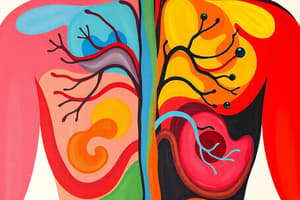Podcast
Questions and Answers
What is the primary function of the sympathetic division of the autonomic nervous system?
What is the primary function of the sympathetic division of the autonomic nervous system?
- Controlling voluntary muscle movements
- Enabling fight-or-flight responses during stress (correct)
- Regulating normal bodily functions during rest
- Promoting digestion and energy conservation
Which of the following receptors is activated first in the autonomic nervous system pathway?
Which of the following receptors is activated first in the autonomic nervous system pathway?
- Muscarinic
- Beta-adrenergic
- Adrenergic
- Nicotinic (correct)
Which of the following statements is true regarding dual-innervation in the autonomic nervous system?
Which of the following statements is true regarding dual-innervation in the autonomic nervous system?
- Some organs require both divisions for complete functional response. (correct)
- Only the sympathetic division is involved in dual-innervation.
- Dual-innervation results in both divisions exciting and inhibiting organs simultaneously.
- Both divisions act independently without influence on one another.
How do adrenergic receptors primarily respond to norepinephrine compared to epinephrine?
How do adrenergic receptors primarily respond to norepinephrine compared to epinephrine?
Which brain structures are NOT directly involved in autonomic control?
Which brain structures are NOT directly involved in autonomic control?
What is the primary function of the parasympathetic nervous system?
What is the primary function of the parasympathetic nervous system?
Which of the following statements accurately describes the vagus nerve?
Which of the following statements accurately describes the vagus nerve?
What is a consequence of overstimulation of the vagus nerve?
What is a consequence of overstimulation of the vagus nerve?
What is required for activation of the cholinergic receptors at the neuromuscular junction?
What is required for activation of the cholinergic receptors at the neuromuscular junction?
Which statement about exogenous toxins affecting acetylcholine is true?
Which statement about exogenous toxins affecting acetylcholine is true?
What type of receptors does the parasympathetic division primarily use?
What type of receptors does the parasympathetic division primarily use?
Which area of the spine does the sympathetic nervous system primarily emerge from?
Which area of the spine does the sympathetic nervous system primarily emerge from?
What secondary response does sympathetic activation of the adrenal medulla trigger?
What secondary response does sympathetic activation of the adrenal medulla trigger?
What is the primary function of chromaffin cells in the sympathetic nervous system?
What is the primary function of chromaffin cells in the sympathetic nervous system?
Which of the following is NOT considered an 'E' situation in the context of sympathetic activation?
Which of the following is NOT considered an 'E' situation in the context of sympathetic activation?
How does cocaine affect norepinephrine levels in the body?
How does cocaine affect norepinephrine levels in the body?
What effect does xylazine have when acting on beta1-adrenergic receptors?
What effect does xylazine have when acting on beta1-adrenergic receptors?
What is the primary consequence of xylazine-induced skin ulceration?
What is the primary consequence of xylazine-induced skin ulceration?
What is the primary effect of botulinum toxin at the neuromuscular junction?
What is the primary effect of botulinum toxin at the neuromuscular junction?
What type of paralysis is caused by botulinum toxin?
What type of paralysis is caused by botulinum toxin?
Which of the following best describes curare's action at the neuromuscular junction?
Which of the following best describes curare's action at the neuromuscular junction?
Which statement is true regarding the various toxins affecting the neuromuscular junction?
Which statement is true regarding the various toxins affecting the neuromuscular junction?
How does AChE (acetylcholinesterase) function at the neuromuscular junction?
How does AChE (acetylcholinesterase) function at the neuromuscular junction?
What role does muscarine play in regard to ACh?
What role does muscarine play in regard to ACh?
What is the action of nightshade or atropine on ACh receptors?
What is the action of nightshade or atropine on ACh receptors?
In the context of the neuromuscular junction, which process follows the binding of ACh to its receptor?
In the context of the neuromuscular junction, which process follows the binding of ACh to its receptor?
Flashcards are hidden until you start studying
Study Notes
Parasympathetic System
- Parasympathetic system is responsible for "rest-and-digest" activities.
- Its nerves originate from the cranial and sacral regions of the spinal cord.
- Key functions include salivation, lacrimation, urination, and defecation (SLUD).
- Ganglia typically lie near or within target tissues.
- The vagus nerve is a major component responsible for 75% of parasympathetic activity.
Sympathetic System
- Responsible for "fight-or-flight" responses.
- Nerves originate from the thoracolumbar region of the spinal cord.
- Key features include chain ganglia, collateral ganglia, and the adrenal medullae.
- The sympathetic chain ganglia function as the first synapse, located close to the spinal cord.
Adrenal Medulla
- The adrenal medulla is a neurosecretory gland responsible for releasing hormones like epinephrine (adrenaline) and norepinephrine (noradrenaline).
- Chromaffin cells in the adrenal medulla are modified post-ganglionic neurons that lack axons.
- Sympathetic activation of the adrenal medulla triggers the fight-or-flight response.
Autonomic Receptors
- Parasympathetic neurons primarily use acetylcholine (ACh) as their neurotransmitter.
- Sympathetic neurons use ACh at the first synapse and norepinephrine (noradrenaline) at the second synapse.
- Sympathetic receptors show greater sensitivity to norepinephrine than epinephrine.
- Acetylcholine receptors can be categorized as nicotinic or muscarinic.
- Nicotinic are found at the first synapse (ganglia) in both sympathetic and parasympathetic divisions, while muscarinic receptors are located at the second synapse (target tissues) in the parasympathetic system.
Autonomic Nervous System
- Characterized by dual innervation, where both sympathetic and parasympathetic systems innervate the same target organs, leading to tonic control.
- One system can either excite or inhibit a target organ, depending on the interaction with the other system.
Neuromuscular Junction (NMJ)
- Controls skeletal muscle movement.
- Uses cholinergic receptors, which are non-specific monovalent ion channels for sodium (Na+) and potassium (K+).
- The activation of these channels requires the binding of two acetylcholine molecules.
Toxins Affecting the NMJ
- Exogenous toxins can disrupt acetylcholine activity at the NMJ, leading to varied consequences.
- Belladonna and atropine (nightshade) are anti-ACh agents that block muscarinic receptors.
- Nicotine acts as an agonist at both central and peripheral nervous system cholinergic receptors.
- Muscarine primarily targets muscarinic receptors in the peripheral nervous system.
- Curare blocks acetylcholine receptors at the NMJ, leading to flaccid paralysis.
- Botulinum toxin prevents the release of acetylcholine, causing flaccid paralysis.
Summary of Toxins and Their Effects
- Botulinum Toxin: Prevents ACh release.
- Curare: Competitively blocks ACh receptors.
- Muscarine: Agonist at muscarinic receptors.
- Belladonna/Atropine: Antagonist at muscarinic receptors.
Studying That Suits You
Use AI to generate personalized quizzes and flashcards to suit your learning preferences.




